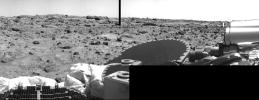 80893_full.jpg (109K) |
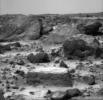 80894_full.jpg (16K) |
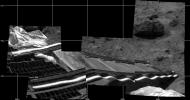 80895_full.jpg (62K) |
| Taken on July 5, this image shows portions of the high gain antenna, a petal, and the retracted airbags. Geologists are eager to examine the rocks of the Ares Vallis terrain. As predicted, the landing site has provided a grab bag of diverse rock types and sizes. | This image was taken on July 5 by the IMP camera. The flat, table-like rock appears to be covered with dust. The rock also displays many interesting linear features. The large rocks in the background are intriguing because of their impressive textures. | This image of the rear (or right) ramp was taken by the IMP camera on July 5, 1997. This ramp was used to deploy the rover. |
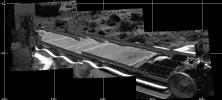 80896_full.jpg (47K) |
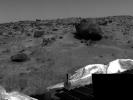 80900_full.jpg (124K) |
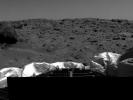 80901_full.jpg (109K) |
| Both the front and rear rover deployment ramps have been deployed. This image shows the front (or left) ramp. The ramps both measure 1 m in length. | This image was taken by the IMP camera before the rover ramps were deployed. The smaller rock in the left portion of the image, named Barnacle Bill, will be the first rock examined by the rover's Alpha Proton X-Ray Spectrometer (APXS). | In the front left of this image is the site of the first measurements taken by the APXS. Over the cold martian night, the rover examined this soil and will transmit the data back to Earth via the lander later this afternoon, July 6. |
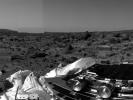 80903_full.jpg (155K) |
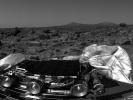 80904_full.jpg (155K) | |
| This image shows the diversity of rocks at the Ares Vallis site. The large rocks seem to lean in a uniform direction (imbrication). This observation suggests that catastrophic floods once ran through the site. Seen on the horizon is a faint peak. | Named Twin Peaks, the formation of two hills in the background are of extreme geological interest. The left hill has a smooth apron which may have been caused by gravitational processes or water. The hill on the right seems to have horizontal bands running through it. As of yet unidentified, the bands may be deposits, sedimentary layers, or terraces cut by erosion. The twin peaks in the distant are approximately 1 mile from the Sagan Memorial Station. The rocks in the foreground are very diverse. Some are rounded and suggest transport by water, others are tabular and angular and indicate non-aqueous deposition. Preliminary hypotheses by Pathfinder geologists are that the angular rocks were thrown from ancient, nearby impact crater sites. | |